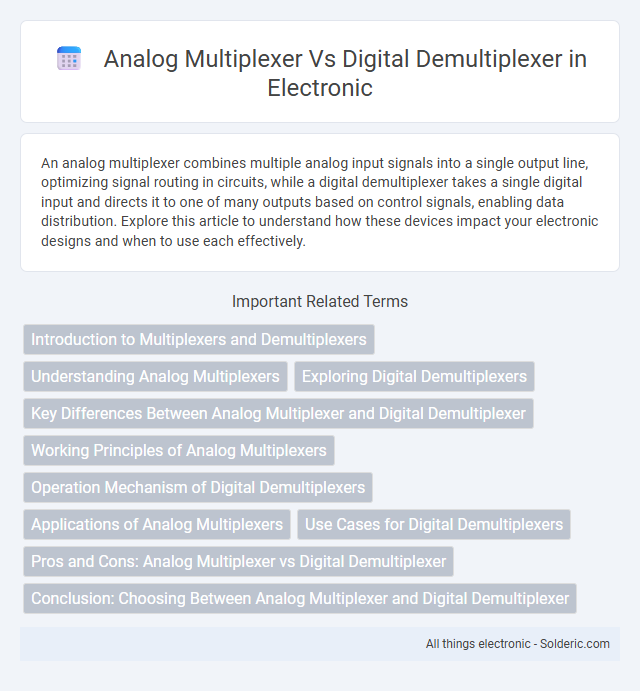An analog multiplexer combines multiple analog input signals into a single output line, optimizing signal routing in circuits, while a digital demultiplexer takes a single digital input and directs it to one of many outputs based on control signals, enabling data distribution. Explore this article to understand how these devices impact your electronic designs and when to use each effectively.
Comparison Table
| Feature | Analog Multiplexer | Digital Demultiplexer |
|---|---|---|
| Function | Selects one analog input from multiple inputs to a single output | Distributes a single digital input to one of many digital outputs |
| Signal Type | Analog signals | Digital signals |
| Control Inputs | Binary select lines used to choose input channel | Binary select lines used to choose output channel |
| Output Channels | Single output channel | Multiple output channels |
| Usage | Data routing in analog circuits and signal processing | Digital signal routing and decoding |
| Device Examples | CD4051, MAX4617 | 74HC138, 74LS154 |
Introduction to Multiplexers and Demultiplexers
Multiplexers and demultiplexers are essential components in digital and analog signal processing, enabling efficient data routing and channel management. An analog multiplexer selects one input signal from multiple analog inputs to forward to a single output, optimizing signal transmission in devices like audio mixers and sensors. In contrast, a digital demultiplexer takes a single digital input and directs it to one of several outputs, allowing your system to distribute data streams accurately across multiple channels.
Understanding Analog Multiplexers
Analog multiplexers efficiently route multiple continuous analog signals to a single output channel, leveraging transistor switches to maintain signal integrity with minimal distortion. Key parameters include on-resistance, bandwidth, and crosstalk, which influence the performance in applications such as audio signal processing and sensor data acquisition. Understanding these characteristics is essential for selecting the right analog multiplexer in complex mixed-signal systems.
Exploring Digital Demultiplexers
Digital demultiplexers efficiently route a single input signal to one of many outputs based on binary control signals, making them essential for data distribution in communication systems and digital circuits. These devices operate by decoding the select lines to activate the corresponding output channel, enabling precise control over signal flow. Your understanding of digital demultiplexers enhances the ability to design complex data routing architectures compared to analog multiplexers, which handle continuous signals without discrete output selection.
Key Differences Between Analog Multiplexer and Digital Demultiplexer
Analog multiplexers select one of several analog input signals and output it through a single channel, effectively routing continuous voltage levels. Digital demultiplexers take a single digital input and distribute it to one of several output lines based on select signals, handling discrete binary data. Your choice depends on whether you need to manage analog signals or route digital information in your circuit design.
Working Principles of Analog Multiplexers
Analog multiplexers operate by using control signals to select one of several analog input channels, routing the chosen signal to a single output line through electronic switches, such as MOSFETs or CMOS transistors. These devices maintain the integrity of analog signals by minimizing distortion and providing a low-resistance path, enabling efficient signal transmission within circuits. The working principle relies on channel selection based on binary control inputs, which directly control the conductivity of the internal switches to connect the desired input to the output.
Operation Mechanism of Digital Demultiplexers
Digital demultiplexers operate by taking a single input signal and routing it to one of several output lines based on binary select inputs, effectively reversing the multiplexing process. Your digital demultiplexer utilizes control signals to determine which output channel receives the input, enabling efficient data distribution in digital circuits. This precise operation contrasts with analog multiplexers, which switch analog signals without digital control logic.
Applications of Analog Multiplexers
Analog multiplexers are essential in data acquisition systems, enabling multiple analog signals to share a single analog-to-digital converter channel, which significantly reduces hardware complexity and cost. They are widely used in automation and instrumentation for sensor data collection, medical devices to route various bio-signals, and audio/video routing systems to manage multiple input sources. Their ability to efficiently handle continuous-time signals makes them indispensable in communication systems, industrial control, and test equipment applications.
Use Cases for Digital Demultiplexers
Digital demultiplexers are essential in digital circuits for routing a single input signal to one of many output lines based on control signals, making them ideal for applications like data distribution, signal routing, and resource sharing in communication systems and microprocessors. They enable efficient management of data flow in multiplexed communication channels and memory address decoding in computer architectures. Your system improves performance by ensuring precise and fast selection of output paths without introducing analog signal distortion.
Pros and Cons: Analog Multiplexer vs Digital Demultiplexer
Analog multiplexers efficiently route multiple analog signals into a single output channel, reducing wiring complexity and saving board space but may introduce signal degradation and noise. Digital demultiplexers excel in directing a single digital input to one of several outputs with high speed and precision, though they require additional control logic and consume more power. While analog multiplexers are ideal for continuous signal management, digital demultiplexers provide superior performance in discrete signal distribution but lack analog signal fidelity.
Conclusion: Choosing Between Analog Multiplexer and Digital Demultiplexer
Selecting between an analog multiplexer and a digital demultiplexer depends on the application's signal type and direction of data flow. Analog multiplexers handle multiple analog input signals and route them to a single output, making them ideal for analog signal routing in measurement or audio systems. Digital demultiplexers, conversely, distribute a single digital input to multiple outputs, suited for digital logic circuits and communication systems where signal direction and channel separation are crucial.
Analog multiplexer vs digital demultiplexer Infographic

 solderic.com
solderic.com